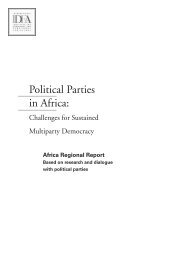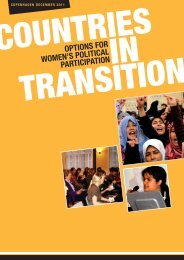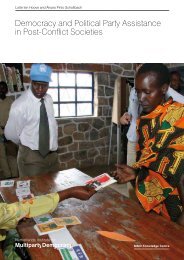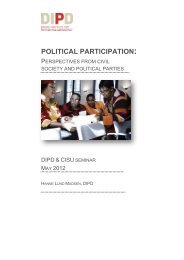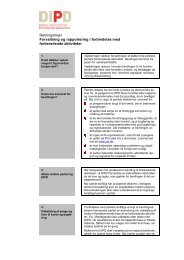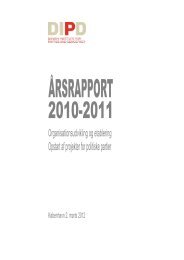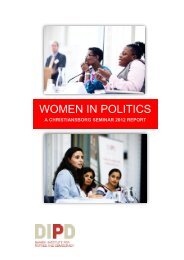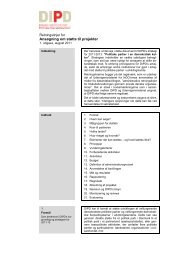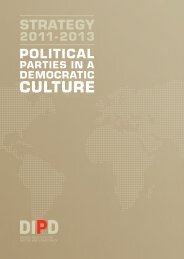Background Document - Danish Institute for Parties and Democracy
Background Document - Danish Institute for Parties and Democracy
Background Document - Danish Institute for Parties and Democracy
Create successful ePaper yourself
Turn your PDF publications into a flip-book with our unique Google optimized e-Paper software.
litical parties ‘rely on the state to fund their activities’. 1 In other words, it could be said<br />
that while there is an overall decline in political engagement, there is also an overall<br />
lack of interest in engaging new, active members in political parties.<br />
THE CHALLENGE OF GETTING MORE WOMEN INTO POLITICS<br />
The challenge of the overall decline of membership numbers is rein<strong>for</strong>ced by the historical<br />
challenges women have had in getting a fair share of the political scene. Young<br />
women may be facing the same daunting challenges. Any move in getting more young<br />
women into political parties will need to have an underst<strong>and</strong>ing of these challenges.<br />
Only since the beginning of the 20th century did women start to have the right to<br />
vote. For some countries, such as Saudi Arabia, women will have the right to vote <strong>and</strong><br />
to run <strong>for</strong> municipal election only in 2015. Switzerl<strong>and</strong> gave women the right to vote<br />
in the 1990s.<br />
Explanations justifying not giving women the right to vote include: Women were<br />
not interested in politics; it is impossible to find women who want to run <strong>for</strong> elections;<br />
<strong>and</strong> women would vote as their priest directed. In some countries active political<br />
policies had to be put in place in order to promote the greater inclusion of women<br />
in decision-making positions.<br />
Nowadays, few countries have reached equality in political representation <strong>and</strong><br />
while quotas have been implemented in political parties or <strong>for</strong> decision-making positions,<br />
‘its significant effect in having the inclusion of women on c<strong>and</strong>idate lists ultimately<br />
depends on the political will of the parties <strong>and</strong> effective en<strong>for</strong>cement of the<br />
law’. 2<br />
Overall, women still constitute only 19.6 per cent of the members of parliament<br />
around the world. Men have historically dominated parties despite women making<br />
great strides in recent decades. For the most part, the structural constraints women<br />
have to face if they wish <strong>for</strong> a political career are the same within political parties. And<br />
while there may be many women at the base, there are very few at the top. As power<br />
increases, the number of women decreases.<br />
In the seven countries <strong>for</strong> which data was available, 51 per cent of active party<br />
members were women, of which generally only 16 per cent of party presidents or<br />
secretaries were women. Men commonly hold the most senior or powerful positions<br />
(president, secretary general, economic secretary, programming secretary, etc.). Women<br />
tend to occupy less influential positions such as minutes secretary, archivist, or<br />
director of training or culture.<br />
This lack of political representation within political parties is due to its ‘highly<br />
gendered institutions that incorporated women on a different basis from men <strong>and</strong><br />
in ways that impeded their access to leadership positions’. 3 So it is a challenging <strong>and</strong><br />
daunting task facing young women indeed.<br />
THE CHALLENGE OF GETTING MORE YOUNG PEOPLE INTO POLITICS<br />
As <strong>for</strong> women in politics, the challenges <strong>for</strong> young people in politics are just as harsh.<br />
For example, while 65% of the African population are under 35, the parliament of the<br />
different countries of the whole continent do not meet the challenges in matters of<br />
political representation of such a young population. Political parties have historically<br />
ignored young people <strong>and</strong> young people’s interests despite being, on a world scale,<br />
half of the population. And while it is hard <strong>for</strong> young men to attain real opportunities<br />
to reach decision-making positions within political organisations, it is even harder <strong>for</strong><br />
young women.<br />
1 Whiteley, 2011, 22<br />
2 International IDEA, 2012, 11-12<br />
3 International IDEA, 2005, 115<br />
WOMEN IN POLITICS DANISH INSTITUTE FOR PARTIES AND DEMOCRACY PAGE 11



